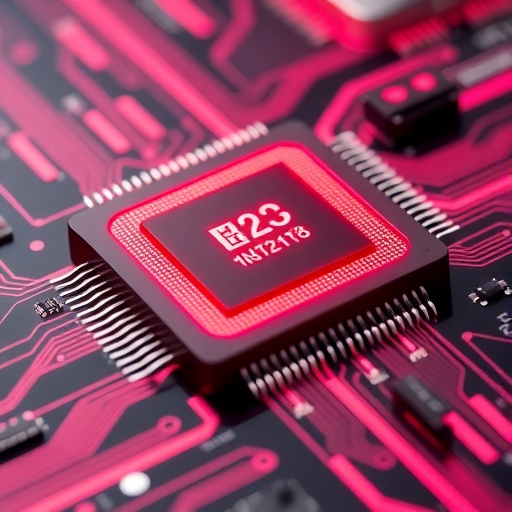In a groundbreaking development that promises to reshape the landscape of semiconductor technology, a team of researchers has unveiled a fully functional two-dimensional (2D) NOR flash memory chip created using the innovative ATOM2CHIP technology. This advancement is more than just an incremental improvement; it marks a significant leap in the practical application of 2D materials in memory devices, successfully bridging the gap between cutting-edge material science and established CMOS (complementary metal-oxide-semiconductor) fabrication techniques.
Traditionally, integrating 2D materials with silicon-based electronics has been fraught with challenges, primarily due to variability in device performance triggered by the microscopic roughness present in CMOS circuitry and damage induced during the packaging process. These issues have historically limited the yield and reliability of 2D-material-based electronic components. The research team’s novel approach involves a comprehensive on-chip integration methodology that mitigates such random stress factors, achieving an impressive fabrication yield of 94.34 percent—a figure that signals readiness for commercial viability.
At the heart of this technological marvel lies the ATOM2CHIP system, a full-stack engineering process that enables the seamless integration of atomically thin 2D materials into existing semiconductor manufacturing workflows. This approach not only preserves the intrinsic properties of the 2D materials but also enhances their operational stability. By maintaining structural integrity and reducing variability, the process has allowed for the fabrication of flash memory cells capable of exceptionally fast switching speeds and energy-efficient operation.
Operating at a high speed of 20 nanoseconds per memory cycle, the developed 2D NOR flash cells demonstrate performance metrics that are highly competitive with conventional silicon-based flash memories. Moreover, the energy consumption is notably low, with just 0.644 picojoules expended per bit during operation. This remarkable efficiency holds the potential to revolutionize memory technologies in power-constrained environments such as mobile devices, edge computing, and Internet of Things (IoT) applications where battery life is at a premium.
Another significant innovation presented in this research is the implementation of a cross-platform system design approach. This framework guarantees compatibility between emergent 2D electronic devices, which often employ unconventional operational mechanisms, and the mature and ubiquitously used CMOS infrastructure. This compatibility is crucial for real-world deployment because it allows next-generation 2D components to be integrated seamlessly into existing electronic systems without requiring radical changes in manufacturing lines or design architecture.
The demonstrated 2D NOR flash architecture also supports instruction-driven operation, a feature that facilitates sophisticated control of memory functions directly at the chip level. In conjunction with this, the chip offers 32-bit parallelism which enables the parallel processing of data streams, substantially increasing throughput and computational efficiency. Importantly, random access capability implemented at a 5-MHz clock speed indicates versatile usability across diverse application scenarios where rapid and arbitrary data retrieval is essential.
This pioneering research signifies a major milestone not only in the realm of non-volatile memory but also broadens the horizons for 2D electronics overall. By harnessing the unique electrical characteristics of layered 2D materials within a highly integrated and scalable chip format, the team has laid down a scalable pathway for integrating 2D materials beyond simple demonstrators into fully realized commercial devices.
The implications of this work stretch far beyond flash memory technology itself. It opens doors for the incorporation of 2D materials into a variety of electronic components, including transistors, sensors, and logic circuits, all benefiting from the high carrier mobility and robust electrostatic control offered by 2D semiconductors. This could lead to ultra-compact, faster, and more energy-efficient electronics, propelling innovation in fields ranging from consumer electronics to advanced computing and artificial intelligence.
Furthermore, the research underscores the importance of meticulous system integration in the advancement of novel materials. It addresses the longstanding problem of bridging the material-level advantages of 2D substances with the rigorous demands of industrial-scale fabrication. By solving the yield and reliability bottlenecks, this methodology sets a new benchmark for future research and development efforts aimed at commercializing 2D electronics.
It’s worth noting that this breakthrough aligns well with the ongoing trend in the semiconductor industry toward heterogeneous integration. Here, combining dissimilar materials and device architectures on a single chip yields enhanced performance and novel functionalities. The successful implementation of ATOM2CHIP technology is a testament to the feasibility of integrating emerging 2D materials with conventional silicon ecosystem, encouraging a broader adoption in next-generation electronic systems.
The energy efficiency observed in the 2D flash cells also points toward sustainability benefits, a crucial factor as digital data grows exponentially and energy consumption in data centers and smart devices escalates. The reduced power requirements contribute not only to longer battery life in portable electronics but also to lowering the overall carbon footprint of computing infrastructure, aligning with global environmental and energy conservation goals.
In conclusion, the full-featured 2D NOR flash chip realized through this systemic integration approach heralds a promising future for 2D electronic devices beyond research laboratories to tangible, practical applications. By overcoming fundamental challenges in material compatibility, packaging, and operational stability, this work provides a definitive pathway to deploy 2D electronics at scale, opening up new avenues for innovation and commercial development in memory technology and beyond.
Subject of Research: Full-featured two-dimensional NOR flash memory chip enabled by system integration using ATOM2CHIP technology.
Article Title: A full-featured 2D flash chip enabled by system integration.
Article References:
Liu, C., Jiang, Y., Shen, B. et al. A full-featured 2D flash chip enabled by system integration. Nature (2025). https://doi.org/10.1038/s41586-025-09621-8
Image Credits: AI Generated




